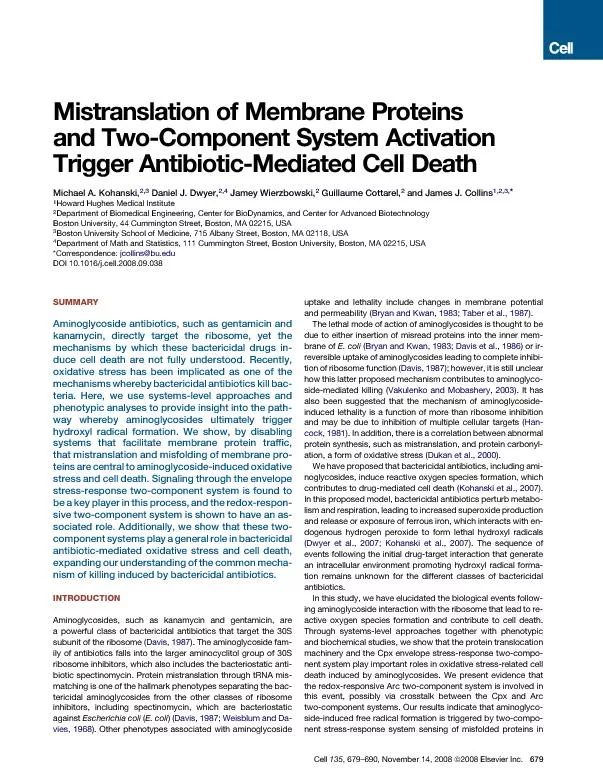/


Figure1Identi ID: 380012
Download Pdf The PPT/PDF document "themembraneandperiplasmicspace,whichshif..." is the property of its rightful owner. Permission is granted to download and print the materials on this web site for personal, non-commercial use only, and to display it on your personal computer provided you do not modify the materials and that you retain all copyright notices contained in the materials. By downloading content from our website, you accept the terms of this agreement.
themembraneandperiplasmicspace,whichshiftsthecellintoastatethatstimulatesandfuelsoxygenradicalgenerationandultimatelyresultsincelldeath.Importantly,wealsodemonstratethattheenvelopestress-responseandredox-responsivetwo-componentsystemsarebroadlyinvolvedinbactericidalantibi-otic-mediatedoxidativestressandcelldeath,providingaddi-tionalinsightintothecommonmechanismofkillinginducedbybactericidalantibiotics.GeneExpressionAnalysisofPathwaysRelatedtoAminoglycosideLethalityWeutilizedgeneexpressionmicroarraysandstatisticalanalyses(seetheExperimentalProcedures)tocomparegeneexpressionpro lesofwild-type(MG1655)E.colitreatedwiththeaminogly-cosidegentamicintoexpressionpro lesaftertreatmentwiththebacteriostaticribosomeinhibitorspectinomycin(TableS1ableonline).Statisticallysigni cantchangesinexpression(zscore)weredeterminedonagene-by-genebasisbycompar-isonofmeanexpressionlevelstoalarge(525)compendiumofE.colimicroarraydatacollectedunderawidevarietyofcondi-tions(seetheExperimentalProcedures).Wethenexaminedtherelativechangesinzscorebetweenbactericidal-andbacterio-static-treatedsamples.Thisallowedustoseparategeneexpres-sionchangesrelatedtoaminoglycosidelethalityandhydroxylradicalformationfromaminoglycosideeffectsoncellgrowth.Toidentifynetworksrelatedtoaminoglycosidelethality,we l-teredthesetofsigni cantlychanginggenesthroughanE.coligeneconnectivitymapgeneratedusingtheelatedness(CLR)algorithm(Faithetal.,2007).AmongtheCLR-predictedconnections,onlythosebetweengenesthatweresigni cantlyperturbed(onthebasisofzscorechanges)andconnectionswhereonenonperturbedgeneconnectedtwosigni cantlyperturbedgenesweremaintained.Thisallowedus Figure1.IdentiÞcationofPathwaysRelatedtoAmi-noglycosideLethalitySigni cantlychanginggenesfromacomparisonoftreatmentwithalethalaminoglycosideversusthebacteriostaticribo-someinhibitorspectinomycin,were lteredthroughanE.coligeneconnectivitymapgeneratedwiththehoodofelatednessalgorithm(Faithetal.,2007);theresultantgenenetworkswereanalyzedforfunctionalenrichment.Thestrainsexhibitingdecreasedgrowthorincreasedgrowthfoundfromahigh-throughputscreenofanE.coligenedeletionlibrarytreatedwithgentamicinwereoverlaidonthesenetworks.toextractgroupsoffunctionallyrelatedgenes(ure1)andgaveusgreaterabilitytofocusonspe-ci cpathwaysrelatedtoaminoglycosidemodeofaction.Wealsoexaminedpreviouslycollectedex-pressionpro les(Kohanskietal.,2007)aftertreat-mentwiththeaminoglycosidekanamycinandcomparedthesetoexpressionpro lesaftertreat-mentwithspectinomycin.Amongthegenenet-worksidenti ed,thereweresixincommonbe-tweengentamicinandkanamycintreatment(Figure2FigureS1),andthesenetworkswereanalyzedforpathwayandtranscriptionfactorenrichment(seetheExperimentalProce-TableS2).Inadditiontoourgeneexpressionanalysis,wealsoutilizedahigh-throughputscreenofanE.coligenedeletionlibrary(Babaetal.,2006)treatedwithgentamicinTableS3;seetheExperimentalProcedures)toidentifypotentialgenetargetswithincreasedsensitivitytogentamicin(TableS4Thegenenetworks(Figure2FigureS1)werefurtheren-richedwiththegrowthdataderivedfromthehigh-throughputscreenoftheE.colisingle-genedeletionlibrary.Amongthenetworksrelatedtoaminoglycosidelethality,oneFigure2A)showedenrichment(p10)forArcA-regulatedel-ementsoftheelectrontransportchain,thetricarboxylicacid(TCA)cycle,andrespiration.ArcAispartoftheArctwo-compo-nentsystem.Ingeneral,two-componentsystems,whichtakepartinimportantbacterialprocessessuchasthecellcycleandvirulence(Hoch,2000),consistofasensorproteinandacog-natetranscriptionfactor;theactivityofthetranscriptionfactorismodulatedbythesensorprotein.TheArctwo-componentsys-temconsistsofaquinone-sensitivesensorkinase,ArcB,whichrespondstotheredoxstateofthecellularquinonepoolbyreg-ulatingthephosphorylationstateofthetranscriptionfactor,ArcAGeorgellisetal.,2001;Malpicaetal.,2004).Inaddition,ArcAac-tivationleadstochangesinexpressionofmanygenesinvolvedinrespirationandmetabolism(LiuandDeWulf,2004WehavepreviouslyshownthatdeletionofsomeoftheTCAcyclegenesinthismetabolism-relatednetwork(Figure2A)at-tenuatebactericidalantibiotic-mediatedcelldeath(etal.,2007).Manyofthesesingle-deletionknockoutsexhibitin-creasedgrowthinthepresenceofgentamicin(Figure2A).Inad-dition,wefound,viaqPCR,thatthevastmajorityofArcA-regulatedTCAcyclegenestestedexhibitedasigni cantspikeingeneexpressionwithinthe rst30minafterexposuretogen-tamicin(FigureS2A).Importantly,thechangesinexpression ,679–690,November14,20082008ElsevierInc. membraneproteins,whichwouldhaveacumulativeeffectontheelectrochemicalpotentialandintegrityofthemembrane.Aminoglycoside-InducedMistranslationofMembraneProteinsInducesHydroxylRadicalFormationandCellOnthebasisofourexpressionanalysis,wefocusedourattentionongenesandpathwaysassociatedwith delityofmembraneproteinstodeterminewhetherthesesystemsarefunctionallylinkedtoaminoglycoside-inducedoxidativestressandlethality.Ananalysisofourhigh-throughputgrowthscreen(TableS3)re-vealed11single-geneknockoutsexhibitingsigni cantde-creasesingrowthaftergentamicintreatment(TableS4).Amongthese11genes,threeofthegeneproducts,H K,H C,andSecG,areinvolvedintheregulationofmembraneproteins,andtwoofthegenes,,showasigni cantincreaseinexpres-sionafteraminoglycosidetreatment(TablesS5andS6E.coli,proteintraf ckingthroughtheinnermembraneoc-cursviamultiplepathways,includingtheSecandsignalrecog-nitionparticle(SRP)translocationsystems.TheSecandSRPpathwaysutilizeachaperone-basedsystemtoshuttleimmatureproteinstotheSecYEGtranslocaseproteincomplexfortrans-portacrosstheinnermembrane(DaneseandSilhavy,1998b;Economou,1999;LuirinkandSinning,2004;MoriandIto,2001;WicknerandSchekman,2005).Immatureproteinsaretar-getedtotheSectranslocase(SecY,SecE,andSecG)bychap-erones(SecBortheSRPsystem)andprocessedthroughtheSecYEGtranslocasebythetranslocationATPaseSecA(mou,1999;Hartletal.,1990;LuirinkandSinning,2004;MoriandIto,2001).SecGworksinconjunctionwithSecAtopromoteef- cientproteintranslocation(Matsumotoetal.,1998).H KandH CtogethernegativelyregulateFtsH(Kiharaetal.,1996,1997;Saikawaetal.,2004),andlossofH KorH Cshoulddi-minishtheabilityofFtsHtodegrademembrane-associatedpro-teins,includingSecYandAkiyamaetal.,1996;Gottesman,1996;Kiharaetal.,1999Todeterminewhethertranslocationofmistranslatedproteinsacrossorintotheinnermembranespeci callyenhanceskillingbyaminoglycosides,weinitiallyfocusedonthreesingle-gene,and.Wetreatedthemwiththemistranslation-inducingaminoglycosidegentamicin,theDNAgyraseinhibitornor oxacin,thecellwallsynthesisinhibitorampi-cillin,andthebacteriostatic,mistranslation-freeaminocyclitol,spectinomycin(seetheSupplementalDataforresultswithspec-tinomycin),respectively.Additionally,weexaminedsurvivalatbothaclinicallyrelevantlevelofgentamicin(5g/ml)andatasub-stantiallyhigherconcentration(15g/ml)(Zaskeetal.,1982,andtreatedwith5g/mlgentamicineachexhibitedasigni cantincreaseinboththerateofkillingandover-allcelldeathrelativetowild-typeE.colitreatedwithgentamicinFigure3A).Incontrast,whenthesesingle-deletionstrainsweretreatedwith100ng/mlnor oxacin(Figure3B)or3g/mlampicil-lin(Figure3C),cellkillingwasquitesimilartothatseenwiththewild-type.Thisdemonstratesthattheincreaseincelldeathob-servedin,andisspeci ctothelethalmech-anismofactionofaminoglycosides.Treatmentofwithahigherconcentrationofgentamicin(15g/ml)sig-ni cantlyreducedthedifferenceinviabilitybetweenthesestrainsandthewild-type(FigureS4).Itisworthnotingthattheremainderofthesingle-genedeletionsidenti edinTableS4didnotdisplayincreasedef cacyofkillingbygentamicin(FiguresS5andS6;seeSupplementalDataforfurtherdiscussion).SecGhasaknownroleinpromotingef cientproteintransloca-tion(Matsumotoetal.,1998),whereastheH KCcomplexregu-latesFtsH,therebyaffectingthedegradationofmembrane-asso-ciatedproteins(Akiyamaetal.,1996;Gottesman,1996;Kiharaetal.,1999).ChangestotheseSecG-orH KC-regulatedfunc-ofmistranslatedproteinsacrossthemem-brane,whichmayaccountfortheobservedincreaseincelldeathFigure3A)afteraminoglycosidetreatmentof,or;seetheSupplementalDataforfurtherdiscussion.Weexaminedhowthesesingle-genedeletionsaffecthydroxylradicalformationandmembranedepolarizationtodeterminewhetherthereisarelationshipbetweenthesephenomenaandanincreaseintranslocationofmistranslatedproteinsacrosstheinnermembrane.Bothradicalformation(Kohanskietal.,)andchangesinmembranepotential(BryanandKwan, Figure3.DisruptingMembraneRegulatorySystemsEnhancesAminoglycosideLethalityPercentsurvivalofwild-typeE.coli(blacksquares),(redcircles),(greentriangles),and(bluetriangles)aftertreatmentwith5g/mlgenta-micin(A),100ng/mlnor oxacin(B),or3g/mlampicillin(C).MeanSEMareshownforall gures. ,679–690,November14,20082008ElsevierInc. 1983;Taberetal.,1987)havebeenassociatedwithaminoglyco-side-mediatedlethality.Consistentwiththeincreaseinkillingef- cacyandtraf ckingofmistranslatedmembraneproteinsafteraminoglycosidetreatment,wefoundthattherewassigni cantlymorehydroxylradicalformation[measuredwiththedye3hydroxyphenyl) uorescein(HPF)(Setsukinaietal.,2003)]in,orthaninthewild-type(Figure4A).Inaddi-tion,hydroxylradicalformationoccurredby1hrafteradditionofgentamicininthesethreemutants,comparedto2hrinthewild-type(Figure4Ifaminoglycoside-inducedhydroxylradicalformationisinfactrelatedtodisruptionoftheelectrochemicalgradientbe-causeofimpropertraf ckingofcorruptmembraneproteins,thechangesinmembranepotentialassociatedwithaminogly-cosidetreatmentshouldre ectchangesinhydroxylradicalfor-mation.Weobservedagradualincreaseinmembranedepolar-ization[measuredwiththedyeDIBAC(3),whichdiffersfrom uorescentintercalatingdyesinthatitcandiffuseacrossdepo-larizedyetintactcellmembranes(Jeprasetal.,1997)]inwild-E.coliby2hr(Figure4B),whichwasconsistentwiththe Figure4.DisruptionofMembraneRegula-torySystemsandtheEnvelopeStressRe-sponseEnhancesAminoglycoside-InducedHydroxylRadicalFormationandMembraneDepolarization(A–D)Fluorescenceforeachstrainrelativetothemaximum uorescenceachievedinthewild-typebackgroundwiththehydroxylradical-detectingdyeHPF(AandC)orthemembranedepolarizationdyeDIBAC(3)(BandD).Hydroxylradicalforma-tion(A)andmembranedepolarization(B)ofwild-typeE.coli(blacksquares),(redcircles),(greentriangles)and(bluetriangles)aftertreatmentwith5g/mlgentamicinareshown.Hydroxylradicalformation(C)andmem-branedepolarization(D)ofwild-typeE.colisquares),(reddiamonds),(greendi-amonds),(reddiamonds),andcircles)aftertreatmentwith5g/mlgentamicinareshown.(E)Fold-changegeneexpressionrelativetobase-line(t=0min)oftheenvelopestress-response(sqaures),and(triangles),forwild-typeE.coli(brown),andDcpxA(green)aftertreatmentwith5gentamicin.onsetofcelldeath(Figure3A)andhy-droxylradicalformation(Figure4,andallexhibitedasigni cantincreaseinmembranede-polarizationby1hr(Figure4B),whichcorrelateswiththesigni cantincreaseinhydroxylradicalformationbeyondwild-typelevels(Figure4A).Thespikesindepolarizationobservedat1hrfor,andFigure4suggestamorecomplexroleformem-branepotentialasrelatedtomembraneproteintraf ckingandtheincreasesincelldeathandradicalInvolvementoftheEnvelopeStress-ResponseandRedox-ResponsiveTwo-ComponentSystemsinDrug-MediatedCellDeathOurresultswith,andpointtowardarelation-shipamongaminoglycoside-inducedchangesinmembraneproteintranslocation,membranedepolarization,andhydroxylradicalformationresultinginrapidcelldeath.Earlychangesinmembranedepolarizationmayre ectchangesintheredoxstateofthecellthatareregulated,inpart,bychangesinexpressionofArcA-regulatedmetabolicgenes(FigureS2).Inaddition,mem-branedepolarizationmayalsore ectchangesinmembranepropertiesbecauseofaminoglycoside-inducedtraf ckingofmistranslatedproteinsacrosstheinnermembrane.Onceproteinsaretranslocatedacrossthemembrane,severaloverlappingcellenvelopemaintenanceandstress-responsesystems(includingtheCpxenvelopestress-responsetwo-com-ponentsystem)areresponsibleforpeptidequalitycontrol ,679–690,November14,20082008ElsevierInc. triggerforaminoglycoside-inducedhydroxylradicalformationFigures7C–7E).Two-componentsystemsareparticularlyusefulinfasttransitionsbetweendifferentenvironments(Hoch,2000anditisinterestingthatafast,protectiveresponsetomisfoldedenvelopeproteinsstimulatedbyCpxAactivationalsoleadstohydroxylradicalformation(Figure7).Intuitively,wewouldexpecttheobservedupregulationinexpressionoftheperiplasmicpro-Figure4E),tobeaprotectiveresponseagainstcelldeathrelatedtomistranslationandaccumulationofcorruptperi-plasmicproteins.However,removalofandtheenvelopestress-responsetwo-componenttranscriptionfactor,,ledtoadecreaseinradicalformationandasigni cantdelayintherateofkillingafteraminoglycosidetreatment(Figures5Aand5B).TheCpxsystemiscontrolledbyatightfeedbackloopthatallowsforfastswitchingbetweenanonandoffstate(etal.,1999).ThisfeedbackmechanisminvolvestheCpxR-regu-latedperiplasmicproteinCpxP(DaneseandSilhavy,1998aCpxP,whichisdegradedbyDegP,negativelyregulatestheac-tivityofCpxA(BuelowandRaivio,2005).Itispossiblethatin-creaseddegradationofCpxPintheperiplasmicspacebyDegPrelievesCpxP-mediatedrepressionofCpxAandenhancestherateofsignalingviaCpxA,ultimatelyleadingtohydroxylrad-icalformation(Figures7C–7E)throughamechanismthatlikelyinvolvesArcA.Ourdata(Figure5)alsosuggestthatoxidativestresstriggeredbyincorporationofmistranslatedproteinsinthecellenvelopeandthefastswitchingcapabilitiesofthetwo-componentsystemsarecriticalfortheinitial,rapid,radical-dependentkillingafteraminoglycosidetreatment.Importantly,ourresultspointtowardabroadrolefortheredoxresponseandenvelopestress-responsetwo-componentsys-temsinbactericidalantibiotic-inducedcelldeath(Figures7and7E).ItislikelythattheroleofArcAhereisthroughmodulationofcellularmetabolism,andadditionaleffortsarerequiredforde-terminationofhowArcA,togetherwithotherregulatoryelementsincludingtranscriptionfactorsandmetabolitecofactors,affectsmetabolismafterantibioticexposure.ArcA-mediatedchangesinmetabolismandrespirationarealsolikelytobeimportantinthecommonoxidativedamagecelldeathpathwayafterexposuretobactericidalantibiotics(Kohanskietal.,2007).TheinvolvementoftheCpxsysteminantibiotic-mediatedcelldeathshowsthatmembraneintegrityiscrucialforbacterialsurvival.Inthecase-lactams,membraneintegrityisaffecteddirectlybythedrug-targetinteraction,whereaswithaminoglycosides,mem-branefunctionandintegrityappearstobemostaffectedbydrug-inducedproteinmistranslation.Therelationshipbetweenquinoloneantibioticsandthemembraneislessclear.TreatmentwiththeDNAgyraseinhibitornalidixicacidhasbeenassociatedwithchangesintheproteintolipidratiointhecellenvelopeDoughertyandSaukkonen,1985).Quinolonesdoinduce la-mentation,anditispossiblethatchangesinmembranecompo-sition,function,andintegritybroughtaboutbyanincreaseincellsizeaffectCpxsignalingandcelldeath.Aminoglycoside-inducedmistranslationinE.coliisspeci -callyduetotheinteractionofthedrugwiththeribosomeFigure7A).Variabilityinthestructureoftheribosomemayaffecttheinductionofmistranslationbyaminoglycosidesandmayalsoinducemistranslationbyotherclassesofribosomeinhibitors.In-terestingly,ribosomalRNAsequencesvaryamongbacterialspecies,andsomeribosomeinhibitorsarebacteriostaticincer-tainspeciesandbactericidalinothers.Forexample,chloram-phenicolisbacteriostaticagainstE.colibutbactericidalagainstHaemophilusinßuenzaRahalandSimberkoff,1979).Itispossi-blethatthevariabilityinribosomalRNAsequencescausessomeribosomeinhibitorstoinducemistranslationandsubsequentmisfoldingofmembraneproteins,therebyloweringthethresholdforhydroxylradicalformationandcelldeathincertainbacterialspecies,whereasinotherspeciesthesesameribosomeinhibi-torsdonotinducemistranslationandaremerelybacteriostatic.Adeeperunderstandingofthislethaltriggermayallowustocon-vertbacteriostaticribosomeinhibitorsintobactericidaldrugsbyidentifyingtargetsthatinduceproteinmistranslationandtherebytriggerradical-basedcelldeath.ThemembraneregulatoryproteinsH KCandSecGFigure7B),knockoutsofwhichwehaveshownenhanceamino-glycosidelethality,interactwithessentialproteins(FtsHandSecE/SecY,respectively)butarenotessentialthemselves).Additionally,SecGisnotconservedoutsideofbacteria,whereasSecEandSecYarewellconservedinhumans(Economou,1999).Earlierworkonglycolipidderivatesofvancomycin(Eggertetal.,2001)hasshownthattargetingnonessentialgenesisaviableoptionforen-hancingantibioticef cacy.Ascombinationtherapyapproachesareexploredfurther(CottarelandWierzbowski,2007),itispos-siblethatnonessentialregulatorsofessentialproteinswillturnouttobehigh-qualitydrugtargetsforpotentiationofknownantibacterialdrugs.Aminoglycosidesareapowerful,broad-spectrumclassofan-tibioticswithexcellentactivityagainstcommoninfectionsinvolv-ingGram-negativebacteria.However,thisclassofdrugshasalimitedtherapeuticindexduetonephrotoxicity(LeclercqandTulkens,1999)andototoxicity(Wuetal.,2002)athigherdosages(e.g.,peakserumconcentrationgreaterthang/mlforgentamicin[Zaskeetal.,1982]).Becauseoftheincreasingprevalenceofresistantbacteria,theeffectivenessofthisdrugclassmaybecomelimited.TargetingofH KCorSecGaspartofacombinationtherapycouldenhancethepo-tencyofaminoglycosides,broadeningtheirtherapeuticindexatlower,nontoxicdosagesandpossiblysensitizingclinicallyre-sistantstrains.EXPERIMENTALPROCEDURESMediaandAntibioticsAllexperimentswereperformedinLuria-Bertani(LB)medium(FisherScien-ti c,Pittsburgh,PA).Forallexperiments,weusedtheaminocyclitolfamilyan-tibioticskanamycin(FisherScienti c),gentamicin(Sigma,St.Louis,MO),orspectinomycin(MPBiomedicals).ScreeningforaminoglycosidesensitivitywasperformedintheE.coligeneknockoutlibrary(BW25113background)(Babaetal.,2006TableS7AllotherexperimentswereperformedwithMG1655-(ATCC700926)()derivedstrains.AllsingleanddoubleknockoutswereconstructedthroughtheuseofP1phagetransduction,andP1stockwasderivedfromtheE.coliknockoutlibrary(Babaetal.,2006TableS7).PositiveP1transductantswerecon rmedbyacquisitionofkanamycinresistanceandPCR.Removalofthekanamycin-resistancecassettewasaccomplishedwiththepcp20 ,679–690,November14,20082008ElsevierInc. per0.3OD,stabilizedimmediatelywith2volumeofRNAprotectBacterialReagent(QIAGEN)asperthemanufacturer’sinstructions,andstoredover-nightatC.TotalRNAwasextractedwithQIAGENRNeasyMinispincol-umnsaccordingtothemanufacturer’sinstructions.TotalRNAwastreatedwithRNase-freeDNase(Ambion,Austin,TX).Foreachsample,reversetran-scriptionof2gtotalRNAwasperformedwiththeSuperscriptIIIReverseTranscriptasekit(Invitrogen)inatotalvolumeof20laccordingtothemanu-facturer’sinstructions.qPCRprimersforeachtranscriptofinterest(TableS8)andthereferencerrsAweredesignedwithsequencesfoundintheEcoCycdatabase(Karpetal.,2007)andPrimerQuestsoftware(IDT,http://www.).Forallprimerpairs,ampliconsizewas100bp,thecalculatedprimerannealingtemperaturewas60C,andprobabilitiesofprimer-dimer/hairpinformationswereminimized.Primerspeci citywascon rmedwithgelelectrophoresis.qPCRreactionsusingDyNAmoHSSYBRGreenqPCRKit(Finnzymes)werepreparedaccordingtomanufacturer’sinstructionswithlofa1:10dilutionofcDNA(20ngoftotalRNA)inatotalvolumeoflcontaining300nMofforwardprimersand300nMofreverseprimers,SYBRGreenMasterMix,and0.1lROXpassivereferencedye.Re-actionswerecarriedoutin384-wellopticalmicroplates(AppliedBiosystems)withanABIPrism7900HT.Crossing-pointthreshold(Ct)andreal-time uores-cencedatawereobtainedwiththeABIPrismSequenceDetectionSoftwarev2.0withdefaultsoftwareparameters.ExpressionlevelswereobtainedfromCtvaluesaspreviouslydescribed(Gardneretal.,2003SUPPLEMENTALDATASupplementalDataincludeSupplementalResultsandDiscussion,Supple-mentalExperimentalProcedures,11 gures,andeighttablesandcanbefoundwiththisarticleonlineathttp://www.cell.com/supplemental/S0092-8674(08)01195-1ACKNOWLEDGMENTSWethankN.GerryforprocessingthemicroarraysandB.Hayeteforhelpfuldis-cussionsongeneexpressionanalysis.WethankM.DePristoforcommentsonthemanuscript.ThisworkwassupportedbytheNationalInstitutesofHealth(NIH)throughtheNIHDirector’sPioneerAwardProgram,grantnumberDP1OD003644,theNationalScienceFoundation(NSF)FrontiersinIntegrativeBi-ologicalResearchprogram,NSFawardEMSW21-RTG,andtheHowardHughesMedicalInstitute.Received:November13,2007Revised:July14,2008Accepted:September15,2008Published:November13,2008Akiyama,Y.,Kihara,A.,Tokuda,H.,andIto,K.(1996).FtsH(H B)isanATP-dependentproteaseselectivelyactingonSecYandsomeothermembraneproteins.J.Biol.Chem.271,31196–31201.Ashburner,M.,Ball,C.A.,Blake,J.A.,Botstein,D.,Butler,H.,Cherry,J.M.,Davis,A.P.,Dolinski,K.,Dwight,S.S.,Eppig,J.T.,etal.(2000).Geneontology:Toolfortheuni cationofbiology.TheGeneOntologyConsortium.Nat.Genet.,25–29.Baba,T.,Ara,T.,Hasegawa,M.,Takai,Y.,Okumura,Y.,Baba,M.,Datsenko,K.A.,Tomita,M.,Wanner,B.L.,andMori,H.(2006).ConstructionofEscheri-chiacoliK-12in-frame,single-geneknockoutmutants:TheKeiocollection.Mol.Syst.Biol.,2006.0008.Bolstad,B.M.,Irizarry,R.A.,Astrand,M.,andSpeed,T.P.(2003).Acompari-sonofnormalizationmethodsforhighdensityoligonucleotidearraydatabasedonvarianceandbias.Bioinformatics,185–193.Boyle,E.I.,Weng,S.,Gollub,J.,Jin,H.,Botstein,D.,Cherry,J.M.,andSherlock,G.(2004).GO:TermFinder–opensourcesoftwareforaccessingGeneOntologyinformationand ndingsigni cantlyenrichedGeneOntologytermsassociatedwithalistofgenes.Bioinformatics,3710–3715.Bryan,L.E.,andKwan,S.(1983).Rolesofribosomalbinding,membranepotential,andelectrontransportinbacterialuptakeofstreptomycinandgen-tamicin.Antimicrob.AgentsChemother.,835–845.Buelow,D.R.,andRaivio,T.L.(2005).Cpxsignaltransductionisin uencedbyaconservedN-terminaldomaininthenovelinhibitorCpxPandtheperiplasmicproteaseDegP.J.Bacteriol.,6622–6630.Camon,E.,Magrane,M.,Barrell,D.,Lee,V.,Dimmer,E.,Maslen,J.,Binns,D.,Harte,N.,Lopez,R.,andApweiler,R.(2004).TheGeneOntologyAnnotation(GOA)Database:SharingknowledgeinUniprotwithGeneOntology.NucleicAcidsRes.,D262–D266.Cottarel,G.,andWierzbowski,J.(2007).Combinationdrugs,anemergingop-tionforantibacterialtherapy.TrendsBiotechnol.,547–555.Danese,P.N.,andSilhavy,T.J.(1998a).CpxP,astress-combativememberoftheCpxregulon.J.Bacteriol.,831–839.Danese,P.N.,andSilhavy,T.J.(1998b).Targetingandassemblyofperiplas-micandouter-membraneproteinsinEscherichiacoli.Annu.Rev.Genet.Danese,P.N.,Snyder,W.B.,Cosma,C.L.,Davis,L.J.,andSilhavy,T.J.(1995).TheCpxtwo-componentsignaltransductionpathwayofEscherichiacolireg-ulatestranscriptionofthegenespecifyingthestress-inducibleperiplasmicprotease,DegP.GenesDev.,387–398.Datsenko,K.A.,andWanner,B.L.(2000).One-stepinactivationofchromo-somalgenesinEscherichiacoliK-12usingPCRproducts.Proc.Natl.Acad.Sci.USA,6640–6645.Davis,B.D.(1987).Mechanismofbactericidalactionofaminoglycosides.Microbiol.Rev.,341–350.Davis,B.D.,Chen,L.L.,andTai,P.C.(1986).Misreadproteincreatesmem-branechannels:Anessentialstepinthebactericidalactionofaminoglyco-sides.Proc.Natl.Acad.Sci.USA,6164–6168.Dougherty,T.J.,andSaukkonen,J.J.(1985).MembranepermeabilitychangesassociatedwithDNAgyraseinhibitorsinEscherichiacoli.Antimicrob.AgentsChemother.,200–206.Duguay,A.R.,andSilhavy,T.J.(2004).Qualitycontrolinthebacterialperi-plasm.Biochim.Biophys.Acta121–134.Farewell,A.,Ballesteros,M.,Taddei,F.,Radman,M.,andNystrom,T.(2000).Proteinoxidationinresponsetoincreasedtranscriptionalortransla-tionalerrors.Proc.Natl.Acad.Sci.USA,5746–5749.Dwyer,D.J.,Kohanski,M.A.,Hayete,B.,andCollins,J.J.(2007).Gyraseinhib-itorsinduceanoxidativedamagecellulardeathpathwayinEscherichiacoli.Mol.Syst.Biol.,91.Economou,A.(1999).Followingtheleader:BacterialproteinexportthroughtheSecpathway.TrendsMicrobiol.,315–320.Eggert,U.S.,Ruiz,N.,Falcone,B.V.,Branstrom,A.A.,Goldman,R.C.,Silhavy,T.J.,andKahne,D.(2001).Geneticbasisforactivitydifferencesbetweenvan-comycinandglycolipidderivativesofvancomycin.Science,361–364.Faith,J.J.,Hayete,B.,Thaden,J.T.,Mogno,I.,Wierzbowski,J.,Cottarel,G.,Kasif,S.,Collins,J.J.,andGardner,T.S.(2007).Large-scalemappingandvalidationofEscherichiacolitranscriptionalregulationfromacompendiumofexpressionpro les.PLoSBiol.,e8.Gardner,T.S.,diBernardo,D.,Lorenz,D.,andCollins,J.J.(2003).Inferringgeneticnetworksandidentifyingcompoundmodeofactionviaexpressionpro ling.Science301,102–105.Georgellis,D.,Kwon,O.,andLin,E.C.(2001).Quinonesastheredoxsignalforthearctwo-componentsystemofbacteria.Science,2314–2316.Gottesman,S.(1996).ProteasesandtheirtargetsinEscherichiacoli.Annu.Rev.Genet.,465–506.Hancock,R.E.(1981).Aminoglycosideuptakeandmodeofaction-withspecialreferencetostreptomycinandgentamicin.II.Effectsofaminoglycosidesoncells.J.Antimicrob.Chemother.,429–445. ,679–690,November14,20082008ElsevierInc. Hartl,F.U.,Lecker,S.,Schiebel,E.,Hendrick,J.P.,andWickner,W.(1990).ThebindingcascadeofSecBtoSecAtoSecY/EmediatespreproteintargetingtotheE.coliplasmamembrane.Cell,269–279.Hoch,J.A.(2000).Two-componentandphosphorelaysignaltransduction.Curr.Opin.Microbiol.,165–170.Iuchi,S.,Furlong,D.,andLin,E.C.(1989).DifferentiationofarcA,arcB,andcpxAmutantphenotypesofEscherichiacolibysexpilusformationanden-zymeregulation.J.Bacteriol.,2889–2893.Jepras,R.I.,Paul,F.E.,Pearson,S.C.,andWilkinson,M.J.(1997).Rapidas-sessmentofantibioticeffectsonEscherichiacolibybis-(1,3-dibutylbarbituricacid)trimethineoxonoland owcytometry.Antimicrob.AgentsChemother.,2001–2005.Karp,P.D.,Keseler,I.M.,Shearer,A.,Latendresse,M.,Krummenacker,M.,Paley,S.M.,Paulsen,I.,Collado-Vides,J.,Gama-Castro,S.,Peralta-Gil,M.,etal.(2007).MultidimensionalannotationoftheEscherichiacoliK-12genome.NucleicAcidsRes.,7577–7590.Kihara,A.,Akiyama,Y.,andIto,K.(1996).AproteasecomplexintheEscher-ichiacoliplasmamembrane:H KC(H A)formsacomplexwithFtsH(H B),regulatingitsproteolyticactivityagainstSecY.EMBOJ.,6122–6131.Kihara,A.,Akiyama,Y.,andIto,K.(1997).Hostregulationoflysogenicdecisioninbacteriophagelambda:TransmembranemodulationofFtsH(H B),thecIIdegradingprotease,byH KC(H A).Proc.Natl.Acad.Sci.USA5544–5549.Kihara,A.,Akiyama,Y.,andIto,K.(1999).DislocationofmembraneproteinsinFtsH-mediatedproteolysis.EMBOJ.,2970–2981.Kohanski,M.A.,Dwyer,D.J.,Hayete,B.,Lawrence,C.A.,andCollins,J.J.(2007).Acommonmechanismofcellulardeathinducedbybactericidalantibi-otics.Cell,797–810.Liu,X.,andDeWulf,P.(2004).ProbingtheArcA-PmodulonofEscherichiacolibywholegenometranscriptionalanalysisandsequencerecognitionpro ling.J.Biol.Chem.,12588–12597.Luirink,J.,andSinning,I.(2004).SRP-mediatedproteintargeting:Structureandfunctionrevisited.Biochim.Biophys.Acta,17–35.Malpica,R.,Franco,B.,Rodriguez,C.,Kwon,O.,andGeorgellis,D.(2004).Identi cationofaquinone-sensitiveredoxswitchintheArcBsensorkinase.Proc.Natl.Acad.Sci.USA,13318–13323.Martin,J.P.,Jr.,Colina,K.,andLogsdon,N.(1987).RoleofoxygenradicalsinthephototoxicityoftetracyclinestowardEscherichiacoliB.J.Bacteriol.2516–2522.Matsumoto,G.,Mori,H.,andIto,K.(1998).RolesofSecGinATP-andSecA-dependentproteintranslocation.Proc.Natl.Acad.Sci.USA,13567–13572.Mingeot-Leclercq,M.P.,andTulkens,P.M.(1999).Aminoglycosides:Nephro-toxicity.Antimicrob.AgentsChemother.,1003–1012.Mori,H.,andIto,K.(2001).TheSecprotein-translocationpathway.TrendsMicrobiol.,494–500.Pogliano,J.,Lynch,A.S.,Belin,D.,Lin,E.C.,andBeckwith,J.(1997).Regula-tionofEscherichiacolicellenvelopeproteinsinvolvedinproteinfoldinganddegradationbytheCpxtwo-componentsystem.GenesDev.,1169–1182.Rahal,J.J.,Jr.,andSimberkoff,M.S.(1979).Bactericidalandbacteriostaticactionofchloramphenicolagainstmemingealpathogens.Antimicrob.Agents,13–18.Raivio,T.L.,Popkin,D.L.,andSilhavy,T.J.(1999).TheCpxenvelopestressre-sponseiscontrolledbyampli cationandfeedbackinhibition.J.Bacteriol.Ronson,C.W.,Nixon,B.T.,andAusubel,F.M.(1987).Conserveddomainsinbacterialregulatoryproteinsthatrespondtoenvironmentalstimuli.CellRuiz,N.,andSilhavy,T.J.(2005).Sensingexternalstress:WatchdogsoftheEscherichiacolicellenvelope.Curr.Opin.Microbiol.,122–126.Saikawa,N.,Akiyama,Y.,andIto,K.(2004).FtsHexistsasanexceptionallylargecomplexcontainingH KCintheplasmamembraneofEscherichiacoli.J.Struct.Biol.,123–129.Salgado,H.,Gama-Castro,S.,Peralta-Gil,M.,Diaz-Peredo,E.,Sanchez-Solano,F.,Santos-Zavaleta,A.,Martinez-Flores,I.,Jimenez-Jacinto,V.,Bonavides-Martinez,C.,Segura-Salazar,J.,etal.(2006).RegulonDB(version5.0):EscherichiacoliK-12transcriptionalregulatorynetwork,operonorgani-zation,andgrowthconditions.NucleicAcidsRes.,D394–D397.Setsukinai,K.,Urano,Y.,Kakinuma,K.,Majima,H.J.,andNagano,T.(2003).Developmentofnovel uorescenceprobesthatcanreliablydetectreactiveoxygenspeciesanddistinguishspeci cspecies.J.Biol.Chem.Storey,J.D.,andTibshirani,R.(2003).Statisticalsigni canceforgenomewidestudies.Proc.Natl.Acad.Sci.USAK.L.,Johnson,K.,andBeckwith,J.(1989).CharacterizationofdegP,agenerequiredforproteolysisinthecellenvelopeandessentialforgrowthofEscherichiacoliathightemperature.J.Bacteriol.,2689–2696.Taber,H.W.,Mueller,J.P.,Miller,P.F.,andArrow,A.S.(1987).Bacterialuptakeofaminoglycosideantibiotics.Microbiol.Rev.,439–457.Umezawa,N.,Arakane,K.,Ryu,A.,Mashiko,S.,Hirobe,M.,andNagano,T.(1997).Participationofreactiveoxygenspeciesinphototoxicityinducedbyquinoloneantibacterialagents.Arch.Biochem.Biophys.,275–281.Vakulenko,S.B.,andMobashery,S.(2003).Versatilityofaminoglycosidesandprospectsfortheirfuture.Clin.Microbiol.Rev.,430–450.Weisblum,B.,andDavies,J.(1968).Antibioticinhibitorsofthebacterialribo-some.Bacteriol.Rev.,493–528.Wickner,W.,andSchekman,R.(2005).Proteintranslocationacrossbiologicalmembranes.Science,1452–1456.Wu,W.J.,Sha,S.H.,andSchacht,J.(2002).Recentadvancesinunderstand-ingaminoglycosideototoxicityanditsprevention.Audiol.Neurootol.Zaske,D.E.,Cipolle,R.J.,Rotschafer,J.C.,Solem,L.D.,Mosier,N.R.,andStrate,R.G.(1982).Gentamicinpharmacokineticsin1,640patients:Methodforcontrolofserumconcentrations.Antimicrob.AgentsChemother. ,679–690,November14,20082008ElsevierInc.